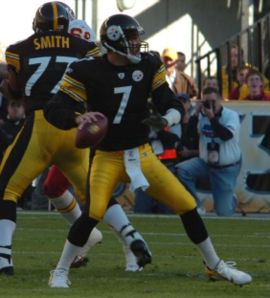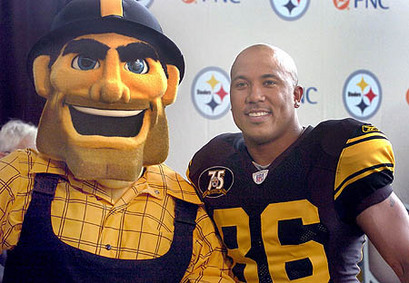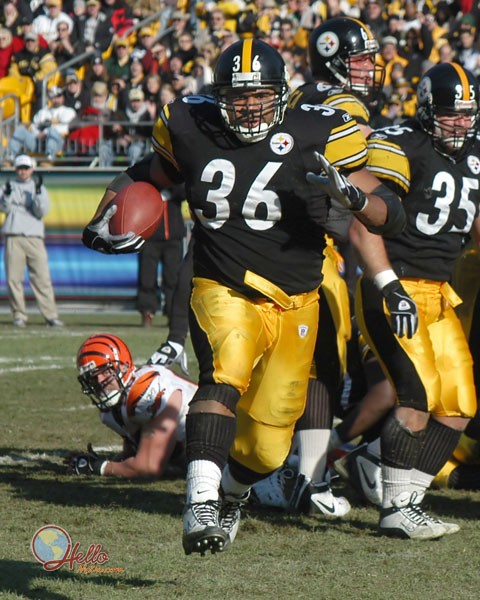
ABOUT
The Pittsburgh Steelers are a professional American football team based in Pittsburgh, Pennsylvania. They are members of the North Division of the American Football Conference (AFC) in the National Football League (NFL). The Steelers are the oldest and most championed franchise in the AFC. The team has appeared in six Super Bowls and, along with the San Francisco 49ers and Dallas Cowboys, is one of three teams to have won the Super Bowl five times. They have appeared in 13 Conference Championship Games and have hosted more conference championship games than any other NFL franchise. They are the only team in NFL playoff history to win a Super Bowl after being seeded sixth in the playoffs, winning three consecutive games on the road followed by a Super Bowl XL victory in Detroit on February 5, 2006 against the Seattle Seahawks. They are also the only sixth-seeded team in NFL history to advance to a conference championship game as well as win one.
Originally named the Pittsburgh Pirates, the team joined the NFL in 1933 when owner Art Rooney Sr. paid a US$2,500 franchise fee to the league. However, the Steelers are the heirs to the first-ever pro-football team, as Pittsburgh hosted the world's first pro game in the 1880s. That early franchise, however, fell victim to the state's strict blue laws that, prior to 1933, prevented sporting events from taking place on Sundays when most NFL games were scheduled.
The franchise was reformed and renamed the Steelers in 1940 based on the city's prominent position in the steel industry. A fan suggested the name in a contest held by the Pittsburgh Post-Gazette and the team.
FANBASE
The Steelers have one of the NFL's largest fan bases, with notable fans being actors Adam Sandler & Michael Keaton, singers Hank Williams, Jr., Bret Michaels, Charlie Daniels, & Snoop Dogg, professional wrestler Kurt Angle, and conservative radio talk show host Rush Limbaugh, among others. (Keaton and Angle being Pittsburgh natives, while Limbaugh once worked at Pittsburgh radio station KQV in the early 1970s.) A 2007 survey also determined that the Steelers also have the largest female fan base in the NFL. The team has sold out every home game since 1972, second to the Green Bay Packers for the longest such streak in NFL history.
FRANCHISE HISTORY
The Pittsburgh Steelers first took to the field as the Pittsburgh Pirates on September 20, 1933, losing 23-2 to the New York Giants. Through the 1930s, the Pirates never finished higher than second place in their division, or with a record better than 0.500 (1936). Pittsburgh did make history in 1938 by signing Byron White, a future justice of the U.S. Supreme Court, to what was at the time the biggest contract in NFL history, but he played only one year with the Pirates before signing with the Detroit Lions.
During World War II, the Steelers experienced player shortages. They twice merged with other NFL franchises to field a team. During the Steagles|1943 season, they merged with the Philadelphia Eagles forming the "Phil-Pitt Eagles" and were known as the "Steagles." This team went 5-4-1. In 1944 they merged with the Chicago Cardinals and were known as Card-Pitt. This team finished 0-10, marking the only winless team in franchise history.
The Steelers made the playoffs for the first time in 1947, tying for first place in the division at 8-4 with the Philadelphia Eagles. This forced a tie-breaking playoff game at Forbes Field, which the Steelers lost 21-0. That would be Pittsburgh's only playoff game for 25 years, though the Steelers did qualify for a "Playoff Bowl" in 1963 as the second best team in their conference, though not considered an official playoff.
In 1970, with the assimilation of the American Football League into the National Football League, the Pittsburgh Steelers were one of three old-guard NFL teams to switch to the newly-formed American Conference (the others being the Cleveland Browns and the Baltimore Colts). This restructuring was necessary to equalize the number of teams in each of the two conferences following the AFL-NFL merger.
The Steelers' history of bad luck changed with the hiring of coach Chuck Noll for the 1969 season. Noll's most remarkable talent was in his draft selections, taking Hall of Famers "Mean" Joe Greene in 1969, Terry Bradshaw and Mel Blount in 1970, Jack Ham in 1971, Franco Harris in 1972, and finally, in 1974, pulled off the incredible feat of selecting four Hall of Famers in one draft year, Mike Webster, Lynn Swann, John Stallworth, and Jack Lambert. The Pittsburgh Steelers' 1974 draft has gone down in NFL history as the best ever, considering no other team has ever drafted four future Hall of Famers in one year. The players drafted in the early '70s formed the base of one of the greatest dynasties in NFL history, making the playoffs in eight seasons and becoming the only team in NFL history to win four Super Bowls in six years, as well as the first to win more than two.
The Steelers suffered a rash of injuries in the 1980 season and missed the playoffs with a 9-7 record. The 1981 season was no better, with an 8-8 showing. The team was then hit with the retirements of all their key players from the Super Bowl years. Mean Joe Greene retired after the 1981 season, Lynn Swann and Jack Ham after 1982's playoff berth, Terry Bradshaw and Mel Blount after 1983's divisional championship, and Jack Lambert after 1984's AFC Championship Game appearance.
After those retirements, the franchise skidded to its first losing seasons since 1971. Though still competitive, the Steelers would not finish above 0.500 in 1985, 1986, and 1988. In 1987, the year of the players' strike, the Steelers finished with a record of 8-7, but missed the playoffs. In 1989, they would reach the second round of the playoffs on the strength of Merrill Hoge and Rod Woodson before narrowly missing the playoffs in each of the next two seasons.
In 1992, Chuck Noll retired and was succeeded by Kansas City Chiefs defensive coordinator Bill Cowher, a native of the Pittsburgh suburb of Crafton.
Cowher led the Steelers to the playoffs in each of his first six seasons, a feat that had been accomplished only by legendary coach Paul Brown of the Cleveland Browns. Overall, Cowher led the Steelers to the playoffs in 10 of his 15 seasons, including an appearance in Super Bowl XXX on the strength of the "Blitzburgh" defense at the end of the 1995 season. However, the Steelers lost to the Dallas Cowboys. Cowher produced the franchise's record-tying fifth Super Bowl win in Super Bowl XL over the National Football Conference champion Seattle Seahawks ten years later. With that victory, the Steelers became the third team to win five Super Bowls, and the first sixth-seeded playoff team to reach and win the Super Bowl since the NFL expanded to a 12-team post-season tournament in 1990.
Cowher resigned from coaching the Steelers on January 5, 2007, citing a need to spend more time with his family. He did not use the term 'retire', leaving open a possible return to the NFL as coach of another team. A three-man committee consisting of Art Rooney II, Dan Rooney, and Kevin Colbert was set-up to conduct interviews for the head coaching vacancy. The candidates interviewed included: offensive coordinator Ken Whisenhunt, offensive line coach Russ Grimm, former offensive coordinator Chan Gailey, Minnesota Vikings defensive coordinator Mike Tomlin, and Chicago Bears defensive coordinator Ron Rivera. On January 22, 2007, Mike Tomlin was announced as Cowher's successor as head coach. Tomlin is the first African-American to be named head coach of the Pittsburgh Steelers in its 74-year history.
Since the NFL merger in 1970, the Pittsburgh Steelers have compiled an overall record of 334-217-2 , reached the playoffs 22 times, won their division 17 times, played in 13 AFC championship games, and won five of six Super Bowls.
LOGOS AND JERSEY
The Steelers have used black and gold as their colors since the club's inception, excluding the 1943 season when they merged with the Philadelphia Eagles and formed the "Steagles"; the team's colors at that time were green and white as a result of wearing Eagles uniforms. Originally, the team wore solid gold helmets and black jerseys. Unique to Pittsburgh, the Steelers' black and gold colors are shared by all major professional teams in the city, including the Pittsburgh Pirates in baseball and the Pittsburgh Penguins in hockey. These also are the colors of the city's official flag.
The Steelers logo was introduced in 1962 and is based on the "Steelmark," originally designed by Pittsburgh's U.S. Steel and now owned by the American Iron and Steel Institute (AISI). In an ironic twist, it was Cleveland-based Republic Steel that suggested the Steelers adopt the industry logo. It consists of the word "Steelers" surrounded by three astroids (hypocycloids of four cusps). The original meanings behind the astroids were, "Steel lightens your work, brightens your leisure, and widens your world." Later, the colors came to represent the ingredients used in the steel-making process: yellow for coal, orange for iron ore, and blue for scrap steel. While the formal Steelmark logo contains only the word "Steel," the team was given permission to add "ers" in 1963 after a petition against AISI.
The Steelers are the only NFL team that puts its logo on only one side of the helmet (the right side). Longtime field and equipment manager Jack Hart was instructed to do this by Art Rooney as a test to see how the logo appeared on the gold helmets; however, its popularity led the team to leave it that way permanently. A year after introducing the logo, they switched to black helmets to make it stand out more.
Another distinctive feature of the helmets is that a player's number appears on both the front and back (the Steelers are one of only two teams in the NFL to this). The numbers traditionally do not appear on the helmet fronts during the exhibition season.
The Steelers have made only a few changes to their jerseys over the years. The team added Northwestern-style stripes to the sleeves in 1936, and with the team finishing 0.500 for the first time in team history that season (at 6-6), the stripes have remained on the uniforms since
After the "Batman" uniforms failed with the fans (the team also finished 4-9-1, last in the short-lived NFL Century Division), the current uniform designs were introduced in 1968. The design was a modernized version of the pre-1967 home design and consists of gold pants and either black jerseys or white jerseys, except for the 1970 and 1971 seasons when the Steelers wore white pants with their white jerseys. The helmet is solid black with a gold central stripe and small white player numbers on the forehead. Last names were added to the jerseys in 1970, as part of a new NFL mandate resulting from the NFL-AFL merger (the AFL teams had last names on the back of their jerseys). In 1997, the team switched to rounded numbers on the jersey to match the number font (Futura Condensed) on the helmets, and a Steelers logo was added to the left side of the jersey.
The Steelers are one of a dwindling number of NFL franchises that strictly wears its team color jerseys at home, always opting for black. The Steelers last wore white at home on a regular basis in 1969, Chuck Noll's first season as coach and the last year the team played in Pitt Stadium. The team has done this for much of its history and has continued to do so as more NFL teams wear white jerseys in at least one home game. They are one of 13 teams since 1999 that have not worn white at home (14 if you count the New York Giants, who wore white in their 2005 "away" game against the New Orleans Saints at Giants Stadium as well as their numerous "away" games against the New York Jets since 1984.), and are the only ones in the AFC North to practice this. The Cleveland Browns have traditionally had on again/off again periods of wearing white at home, while the Baltimore Ravens and Cincinnati Bengals, like some other NFL teams, wear white in their home opener before wearing their darker jerseys in their remaining home games.
Because of the team's unofficial policy of always wearing their black jerseys in home games, the team gained some notoriety when, as the designated "home" team for Super Bowl XL, the team elected to wear their white jerseys, becoming just the third NFL team to elect to wear white as the "home" team in the Super Bowl. But while the other two teams that have elected to wear white as the "home" team in the Super Bowl (Dallas and Washington) traditionally wear white at home, a variety of reasons were rumored as to why the Steelers elected to wear white in Super Bowl XL. Reasons included the fact that the team wore white in all three playoff victories that year (all on the road) to former head coach Bill Cowher's comments that since it wasn't at Heinz Field, it was a road game (a statement contradicted by the fact that ten years earlier in Super Bowl XXX, Cowher's squad was the "home team" and chose to wear their black jerseys away from Three Rivers Stadium, where they had played both playoff games). However, it should be noted though that the game took place in Detroit, which is only a five hour drive from Pittsburgh and with the league preferring to have the Super Bowl in subtropical or Mediterranean climates or in domed/retractable roof stadiums due to the winter weather, is likely the closest the Steelers would have to a home game in a Super Bowl in the foreseeable future. (Not surprisingly, there were also an overwhelming number of Steelers fans at the game compared to the number of supporters of their opponent, the Seattle Seahawks. One ESPN.com columnist suggested that Steelers fans outnumbered Seahawks fans by a ratio of 25 to 1.) Also, the Steelers were the designated "home" team in Super Bowl XIV and elected to wear black (also a season in which they played both their playoff games at home).
At a press conference on April 27, 2007, it was announced that the Steelers would wear a throwback uniform for two home games during the 2007 season, as part of the celebration of the Steelers' 75th Season. They were worn for the Steelers' home opener against the Buffalo Bills on September 16 and again during the Monday Night Football game on November 5 against the Baltimore Ravens. Both games resulted in victories. The jersey is black with the numbers, names and stripes all in gold and it also contains a 75th Season logo on the right side of the upper chest part of the jersey. The jersey is considered to be from the 1960 season. The pants are white with a single gold stripe running down the length of the outside of each leg, surrounded by thinner black stripes on either side of the gold stripe. The helmets are gold with the Steelers logo on the right side and a single black stripe running down the center from front to back. The helmet was worn during the 1962 season, which was the first year that the present Steelers logo began to appear on their helmets. The only two differences are that the logo on the original helmet read 'Steel', whereas Steelers appears on the helmet that the team will wear for the two games in 2007 and that the face mask on this version of the helmet is black, whereas the original face mask color on the gold helmet was gray.
Rivals
The Cleveland Browns and the Steelers have been divisional rivals
since the two cities' teams began playing against each other in 1950. The
all-time series between the two cities was recently taken over by the Steelers
for the first time ever (57-55); partly due to holding an overwhelming 16-3
record against the post-1999 expansion Cleveland Browns franchise, including
winning the last nine straight. Additionally, the Browns lost 16 straight
years in Pittsburgh from 1970–1985 and posted an abysmal 5-24 record
at Three Rivers Stadium overall. Former Steelers head coach Bill Cowher coached
the Browns special teams and secondary before being hired by Pittsburgh after
his brief tenure with Kansas City, which has only served to intensify this
rivalry. Since Cleveland rejoined the league in 1999 (their first game back
being a 43-0 drubbing at the hands of the Steelers in the first game played
at Cleveland Browns Stadium), the rivalry between the teams, while still heated,
has taken a backseat to the Steelers/Ravens rivalry. The original Browns moved
to Baltimore in 1996.
The Baltimore Ravens and the Steelers have had several memorable match-ups
and have a bitter divisional rivalry. Both teams handed the other their first
losses at their current home fields. The Steelers won the inaugural game played
at Baltimore's M&T Bank Stadium in 1998, 20-13, and three years later
the Ravens handed the Steelers their first-ever loss at Heinz Field, 13-10.
Later that season (2001) Pittsburgh won a divisional playoff game 27-10 against
Baltimore, which had appeared in its first Super Bowl the previous season.
During their world championship season in 2000, the Ravens defeated the Steelers
in Pittsburgh, 16-0, in the season opener with the Steelers later exacting
revenge, 9-6, in Baltimore (the Ravens' final loss of the season). The Steelers
lead the series (begun in 1996), 15-9. The two teams complement each other
by consistently fielding strong defenses in their division.
The Cincinnati Bengals rivalry with Pittsburgh dates from the 1970 season,
when the NFL-AFL merger was completed. One of the most memorable games was
the 2005 AFC Wildcard playoff game, in which the Steelers, en route to a Super
Bowl title, won a 31-17 come-from-behind victory after Bengals QB Carson Palmer
was forced to leave the game with a knee injury. The Steelers and Bengals
finished 2005 and 2006 with identical records (11-5 and 8-8 respectively),
splitting both regular-season series, the Bengals winning the tiebreaker both
years due to having a superior division record. The Steelers also are responsible
for ending the Bengals' season in Cincinnati two years in a row, eliminating
them from the playoffs in 2005 and taking them out of contention in 2006.
Historic Rivals
The rivalry between the Steelers and the New England Patriots emerged
when the "cinderella" Patriots upset the Steelers in the 2001 AFC
Championship game at Heinz Field. Pittsburgh did not exact revenge until ending
the Patriots record-setting 21-game winning streak in week #6 of the 2004
NFL season. Later that season, the Steelers lost to the eventual champion
Patriots in the AFC Championship game after a 15-1 season. The two also had
a brief rivalry in the mid 1990s when the Steelers and Patriots split playoff
meetings in 1996 and 1997, in which the Patriots had two young stars with
Pittsburgh-area roots in Ty Law and Curtis Martin. Martin played his last
game as a Patriot against the Steelers in the second playoff game before signing
with the rival New York Jets during the offseason, where he became more well
known. The Patriots have won 5 of the last 6 meetings, including both AFC
Championship match-ups. The teams' next meeting will be at New England on
November 30, 2008.
The rivalry between the Steelers and the Oakland Raiders was the most heated
of the 1970s. The Steelers' first playoff win was a 13-7 victory over the
Raiders by way of Franco Harris's Immaculate Reception on December 23, 1972.
Pittsburgh was knocked out of the playoffs the following year by the Raiders,
but fired back with two straight AFC Championships in 1974 and 1975 over Oakland.
Oakland responded with a victory over Pittsburgh in the 1976 AFC Championship
(the third consecutive AFC title game between the two teams), but not before
Chuck Noll has referred to Geroge Atkinson's hit in Lynn Swann during a regular-season
matchup as part of the NFL's "criminal element". Atkinson and the
Raiders later filed a defamation of character lawsuit against Noll, but lost.
While the rivalry has dissipated over the years (mostly due to Oakland's decline
in recent seasons), the teams have had notable games against each other including
an upset Raider victory in week #8 of the 2006 NFL season (20-13), which helped
cost the Steelers a playoff berth. The teams' next meeting will be at Pittsburgh
in 2009.
The rivalry between the Steelers and the Dallas Cowboys started with the Cowboys'
first game as a franchise in 1960 (against the Steelers) at the Cotton Bowl
with the Steelers coming away with a 35-28 victory. These teams hold a record
for the most times (three) that two teams have met in a Super Bowl. The first
two times the Steelers and Cowboys met came with Pittsburgh victories in Super
Bowl X and Super Bowl XIII to become the Team of the '70s (in fact, between
the Cowboys and Steelers, Super Bowl XIII had the highest number of future
hall of famers participating). The teams featured an all-star matchup at quarterback
between the Steelers' Terry Bradshaw and the Cowboys' Roger Staubach, both
of whom are in the Hall of Fame. In 1977, Staubach and the Cowboys went on
to win Super Bowl XII, their last loss of that season being inflicted by Bradshaw
and the Steelers, 28-13 at Three Rivers Stadium two months before. In 1979,
nine months after Super Bowl XIII, the two teams met again at Three Rivers,
the Steelers winning 14-3 in the last meeting ever between Bradshaw and Staubach.
The Steelers won two of three meetings during the 1980s, with the Cowboys
winning all four meetings during the 1990s, including the teams' record third
Super Bowl meeting in 1996, as this time the heavily-favored Cowboys beat
the Steelers 27-17. Dallas cornerback Larry Brown intercepted Pittsburgh quarterback
Neil O'Donnell twice and was named the game's MVP. The teams' first meeting
of the 21st century went to the Steelers in 2004. Their next meeting will
be at Pittsburgh on December 7, 2008, which has already gotten some hype after
Ben Roethlisberger mentioned that he plans on sending Tony Romo and Jessica
Simpson to Mexico after the game.[20] This is in reference to Romo and Simpson
going to Mexico shortly before the Cowboys loss to the eventual Super Bowl.









